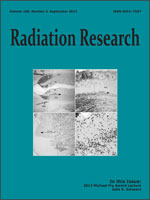A mechanism-based, two-parameter biophysical model of cell killing was developed with the aim of elucidating the mechanisms underlying radiation-induced cell death and predicting cell killing by different radiation types, including protons and carbon ions at energies and doses of interest for cancer therapy. The model assumed that certain chromosome aberrations (dicentrics, rings and large deletions, called “lethal aberrations”) lead to clonogenic inactivation, and that aberrations derive from μm-scale misrejoining of chromatin fragments, which in turn are produced by “dirty” double-strand breaks called “cluster lesions” (CLs). The average numbers of CLs per Gy per cell were left as a semi-free parameter and the threshold distance for chromatin-fragment rejoining was defined the second parameter. The model was “translated” into Monte Carlo code and provided simulated survival curves, which were compared with survival data on V79 cells exposed to protons, carbon ions and X rays. The agreement was good between simulations and survival data and supported the assumptions of the model at least for doses up to a few Gy. Dicentrics, rings and large deletions were found to be lethal not only for AG1522 cells exposed to X rays, as already reported by others, but also for V79 cells exposed to protons and carbon ions of different energies. Furthermore, the derived CL yields suggest that the critical DNA lesions leading to clonogenic inactivation are more complex than “clean” DSBs. After initial validation, the model was applied to characterize the particle and LET dependence of proton and carbon cell killing. Consistent with the proton data, the predicted fraction of inactivated cells after 2 Gy protons was 40–50% below 7.7 keV/μm, increased by a factor ∼1.6 between 7.7–30.5 keV/μm, and decreased by a factor ∼1.1 between 30.5–34.6 keV/μm. These LET values correspond to proton energies below a few MeV, which are always present in the distal region of hadron therapy spread-out Bragg peaks (SOBP). Consistent with the carbon data, the predicted fraction of inactivated cells after 2 Gy carbon was 40–50% between 13.7–32.4 keV/μm, it increased by a factor ∼1.7 between 32.4–153.5 keV/μm, and decreased by a factor ∼1.1 between 153.5–339.1 keV/μm. Finally, we applied the model to predict cell death at different depths along a carbon SOBP used for preclinical experiments at HIMAC in Chiba, Japan. The predicted fraction of inactivated cells was found to be roughly constant (less than 10%) along the SOBP, suggesting that this approach may be applied to predict cell killing of therapeutic carbon beams and that, more generally, dicentrics, rings and deletions at the first mitosis may be regarded as a biological dose for these beams. This study advanced our understanding of the mechanisms of radiation-induced cell death and characterized the particle and LET dependence of proton and carbon cell killing along a carbon SOBP. The model does not use RBE values, which can be a source of uncertainty. More generally, this model is a mechanism-based tool that in minutes can predict cell inactivation by protons or carbon ions of a given energy and dose, based on an experimental photon curve and in principle, a single (experimental) survival point for the considered ion type and energy.
How to translate text using browser tools
14 August 2013
A Model of Radiation-Induced Cell Killing: Insights into Mechanisms and Applications for Hadron Therapy
Francesca Ballarini,
Saverio Altieri,
Silva Bortolussi,
Elio Giroletti,
Nicoletta Protti
ACCESS THE FULL ARTICLE

Radiation Research
Vol. 180 • No. 3
September 2013
Vol. 180 • No. 3
September 2013




